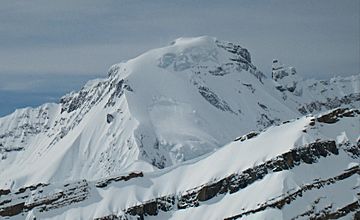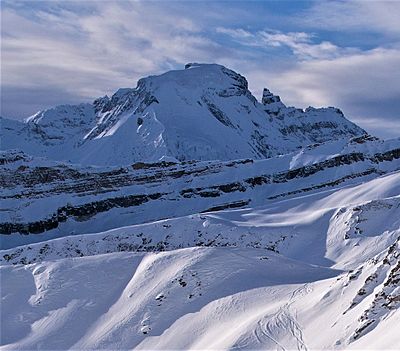Icefall Peak facts for kids
Quick facts for kids Icefall Peak |
|
|---|---|

Icefall Peak
|
|
| Highest point | |
| Elevation | 3,195 m (10,482 ft) |
| Prominence | 275 m (902 ft) |
| Parent peak | Rostrum Peak (3284 m) |
| Geography | |
| Location | British Columbia, Canada |
| Parent range | Canadian Rockies |
| Topo map | NTS 82N14 |
| Geology | |
| Age of rock | Cambrian |
| Type of rock | sedimentary rock |
| Climbing | |
| First ascent | 1954 S.B. Hendricks, D. Hubbard, Dr. and Mrs. E.K. Karcher, A.E. Peterson |
| Easiest route | Mountaineering |
Icefall Peak is a 3,195-metre (10,482-foot) mountain summit located in the Canadian Rockies of British Columbia, Canada. Icefall Peak is situated on the Bush Mountain massif, and its nearest higher peak is Rostrum Peak, 2 km (1.2 mi) to the south-southeast. The peak was named in 1918 by the Interprovincial Boundary Survey for an icefall on its eastern flank, and was officially adopted in 1924 when approved by the Geographical Names Board of Canada. The first ascent of the mountain was made in 1954 by S.B. Hendricks, D. Hubbard, Dr. and Mrs. E.K. Karcher, and A.E. Peterson.
Geology
Icefall Peak is composed of sedimentary rock laid down during the Precambrian to Jurassic periods. Formed in shallow seas, this sedimentary rock was pushed east and over the top of younger rock during the Laramide orogeny.
Climate
Based on the Köppen climate classification, Icefall Peak is located in a subarctic climate zone with cold, snowy winters, and mild summers. Temperatures can drop below −20 °C with wind chill factors below −30 °C.




